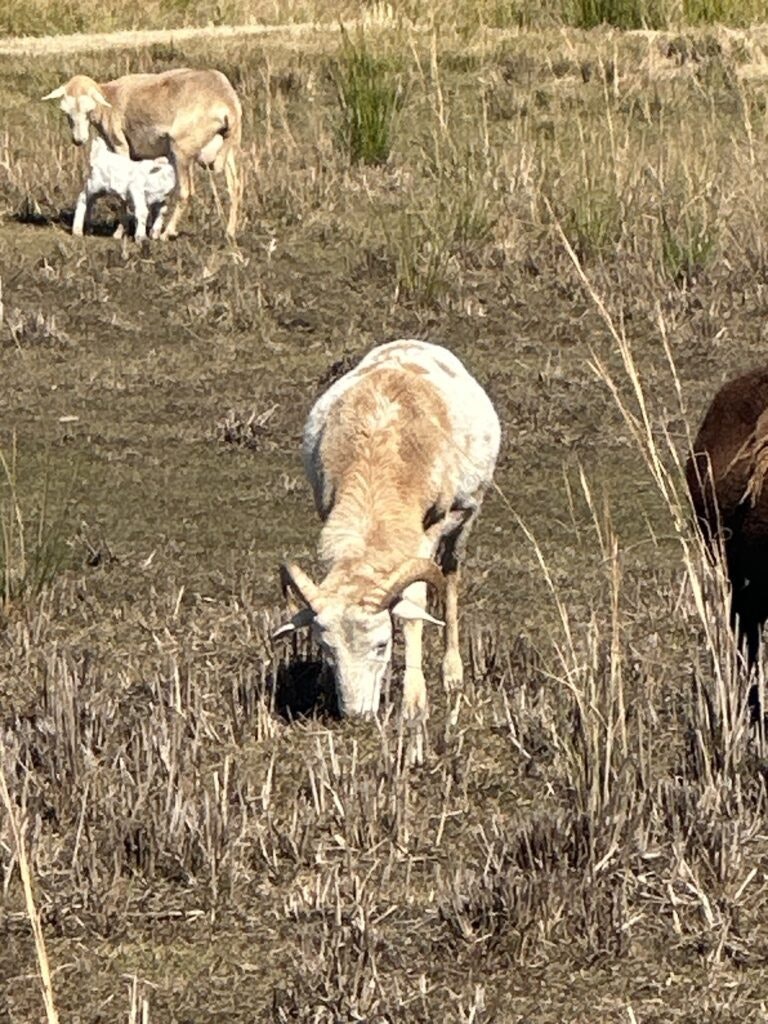Shepherds of Polk City

38 Years Strong in a Field of Their Own
by REBEKAH PIERCE
Central Florida is known for its thriving cattle industry, as well as for crops like citrus, tomatoes, watermelon, and bell peppers. While agriculture has been the name of the game since the area was settled, all the way back in the mid-1800s, sheep farming probably isn’t what comes to mind first when you envision all that Polk County has to offer.
“There’s no official industry,” says Luis Rodriguez, UF/IFAS Extension Small Farms Agent. “There are a couple of people that have 20 sheep, 10 or so, on their farms. Most of the sheep production [here] is for meat purposes, not so much for milk or wool.”
Nonetheless, sheep are what John Oehrl and his wife, Morgan, know best. Married since 1986, the couple have been raising sheep for almost as long as they’ve been together.
“At the time, we had 10 acres,” recalls Oehrl of their humble origins. “Now, we have 20 acres. One of my work associates was at an auction and bought these sheep and said, ‘Hey, you need to have these.’ ” From the beginning, the goal of Oehrl and his wife has simply been to increase the flock to a manageable size. They started their Polk City farm with just a handful of Florida Native sheep, along with a few horses and cows. Today, they have 50 sheep.
Oehrl has a laid-back approach to farming. He enjoys raising sheep because, he says calmly, “They’re just easy. Easy on your fences, not like a goat, which will stand on or jump your fence and be over to the neighbors.”
On Oehrl’s farm, the back 18 acres are entirely dedicated to sheep, where the animals graze all day long and don’t have to be supplemented with any other kind of feed. “They’re purely grass-fed,” he says.
Florida Natives are believed to be one of the oldest breeds in North America, first brought to the Sunshine State by the Spanish in the 1500s. They’re naturally adapted to hot, humid conditions, but can also tolerate drought, cold, and winds with ease.

Unlike cattle farming, which has a robust and well-defined market, sheep farming in Polk County is niche.
“There’s not much demand for the meat and for the products,” Rodriguez says. “It’s a niche market, but not a huge market. They require less land to produce, but if you don’t have the demand for the product…” he trails off, as the implication is clear.
But that’s not to say Oehrl is without buyers. He raises Florida Natives with a specific goal in mind: to produce breeding stock. His animals have high-quality genetics and, since the breed can be tough to find, Oehrl hasn’t had many problems finding markets. Most of his sales come from repeat customers who know exactly what they’re looking for, though certainly not all.
“One Saturday, I was fixing to go to the market,” he recalls. “I stopped and got gas and some guy came up with a trailer and said, ‘I’ll buy all those sheep off you.’ I said, ‘OK, how much?’ He gave me a fair price and we backed our trailers up and I went home.”
On Oehrl’s farm, mornings start with the sheep leaving the barn for grazing. They return to the safety of the barn again every evening.
“The day-to-day care is really slim to none unless you’re trimming a hoof,” he says. “The only downside is predators. Coyotes and bobcats are the biggest ones.”
Oehrl’s flock is small enough that simple management steps like this have been enough to keep predators out, but he notes that a neighbor who raises sheep has added guardian dogs to her flock for an added security measure.
Besides predators, Oehrl says, he doesn’t know of any good reason why more people aren’t raising sheep, especially here in Polk County, where the conditions are favorable for grazing animals on pasture year-round with minimal supplemental feeding required.
“They think sheep eat the grass down to nothing and that’s not true,” he clarifies. “[At one time], we had 70 head of sheep, the cows, and the horses [grazing] and I still had to bush hog the back 18.”
For those thinking of raising sheep for themselves, Oehrl offers a bit of enthusiastic advice: “Have good fences. Know your neighbors. Have a water supply and shelter. And [have] ample enough land so you don’t have to supplement feed them.”
Rodriguez says that the UF/IFAS Extension offers ample support to burgeoning sheep farmers through books, publications, and more. It even offers site visits. He recommends that people with sheep and goats also consider FAMACHA training to help avoid and address parasites.
As for getting too emotionally attached, it doesn’t seem to create a problem for the Oehrls.
“My wife names most of the sheep,” he remarks, adding that once, when a lamb was rejected by its mother, he and his wife decided to bottle-feed it.
“At times, when I was working my job, I would take the lamb with me.”
For the Oehrls, raising sheep has proven to be a rewarding, if unconventional, choice. It fits their lifestyle perfectly, balancing husbandry, attention to detail, and of course, the occasional surprise sale at a gas stat
